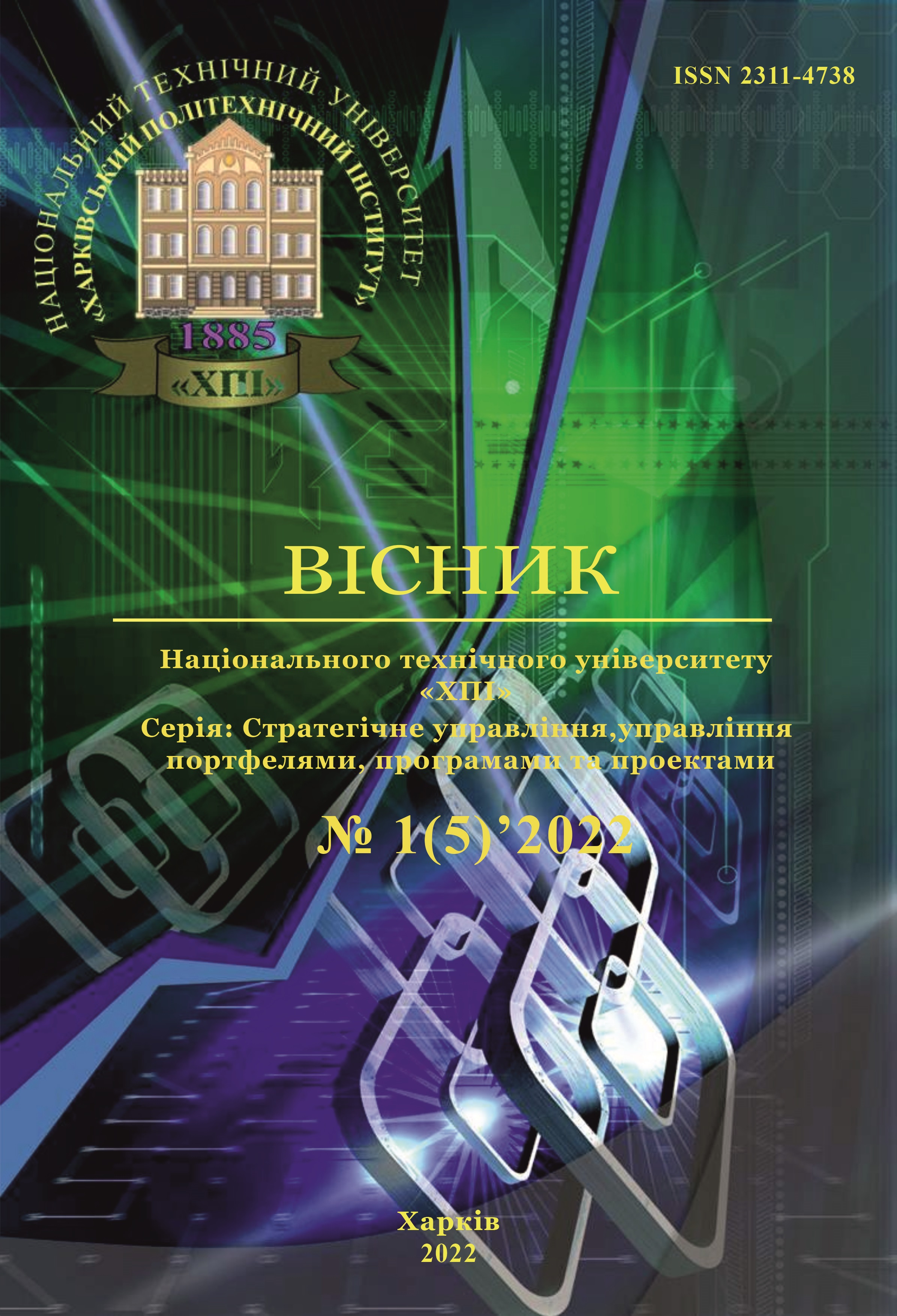SYSTEM MODEL OF COMMUNICATION PARTICIPANTS 'COMMUNICATION PROCESSES
DOI:
https://doi.org/10.20998/2413-3000.2022.5.4Keywords:
communication processes; project participants; system model; type of communication; protocol modelAbstract
The subject matter of the article is the stakeholder’s communication processes of infrastructure development projects. The goal is to develop a formalized systemic model of the communication processes interaction between project stakeholders and project team in a virtual office environment. The following methods are applied: systemic analysis, set-theoretic models. The article solves the following problem: the basic communication management terms defined, the communication types defined, existing communication models analyzed, stakeholders communication processes set-theoretic systematic model developed. The following results are obtained: project management communication processes were analyzed; the project communication processes between stakeholder’s importance was demonstrated; communication process content and term were defined; fundamental project communication processes, that are necessary for the timely and correct project data generation, collecting, distribution and saving, were defined; project communication processes were classified, by assessing existing project management systems; project communication management stages and centralized/decentralized communication structure types were defined; fundamental linear/non-linear project communication processes were examined; communication processes modeling and formal application were analyzed; 3-component communication system model was proposed; proposed communication model characterized the communication act sequence and consist of a set of vertices - communication acts and connecting edge set, what shows the ability to move from current act to the next one. Conclusions: Formalized communication model as a system model gives the ability to solve the time optimization and security problems of the project virtual offices. Particular activities and communications of the general project tasks set, where the project team and other stakeholders simultaneous cooperation is required, should be taken into account.
References
Pakhale P. D., Pal А. Digital project management in infrastructure project: a case study of Nagpur Metro Rail Project. Asian Journal of Civil Engineering. 2020. Vol. 21. P. 639–647. DOI: 10.1007/s42107-020-00224-4.
Ikediashi D. I., Ogunlana S. O., Alotaibi A. Analysis of project failure factors for infrastructure projects in Saudi Arabia: a multivariate approach, Journal of Construction in Developing Countries. 2014. Vol. 19. P. 35–52.
Cervone H. F. Effective communication for project success. OCLC Systems & Services: International digital library perspectives. 2014. Vol. 30. No. 2. Р. 74-77. doi.org/10.1108/OCLC-02-2014-0014
Cervone Turner J. R., Müller R. Communication and Cooperation on Projects Between the Project Owner As Principal and the Project Manager as Agent. European Management Journal. 2004. Vol. 22, Issue 3. Pp. 327-336. doi.org/10.1016/j.emj.2004.04.010
Cervone Vanita A., Priyadarshini Sh. Effective Communication Management for Urban Infrastructure Projects. Project Management National Conference, India. 2015. URL: https://www.researchgate.net/publication/282439575_ Effective_Communication_Management_for_Urban_Infrastructure_Projects – Дата звертання : 19.11.2021.
Project management institute 2013 annual report. URL: http://www.pmi.org/AbouUs/~/media/PDF/Publications/ PMI-2013-Annual-Report-Web.ashx – Дата звертання : 20.11.2021.
Meng X., Boyd P. The role of the project manager in relationship management. International Journal. Project Management. 2017. Vol. 35. No. 1. P. 717–728.
Bentahar O., Lavagnon A. Matching the Project Manager's Roles to Project Types: Evidence From Large Dam Projects in Africa. IEEE Transactions on Engineering Management. 2019, March. P. 1-16.
An American National Standard ANSI/PMI99–001–2004, Руководство по управлению инновационными проектами и программами предприятий. Японская ассоциация управления проектами PMAJ(ua). К. : Науковий світ, 2009. 175 c.
Бушуев С. Д., Бушуева Н. С. National Competence Baseline, NCB UA Version 3.1,. К. :ІРІДІУМ, 2010.–208 с.
Jurgensa M., Berthonb P., Papaniac L. Stakeholder theory and practice in Europe and North America: the key to success lies in a marketing approach. Industrial Marketing Management. 2010. Vol. 39(5). P. 769–775.
Malyeyeva O., Lytvynenko D., Kosenko V., Artiukh R. Models of Harmonization of Interests and Conflict Resolution of Project Stakeholders. Proceedings of the 1st International Workshop IT Project Management (ITPM 2020). Slavsko: 2020. P. 24–35. ISSN 1613-0073.
Бушуєв С. Д. Практика проектного менеджменту «крок за кроком». Ч. 1. URL: http://elearn.univector.net/mod/resource/view.php?id=1229. Дата звертання : 24.10.2021.
Кадыкова И. Н., Ларина С. А., Чумаченко И. В. Информационная технология стратегического управления проектно-ориентированной организацией. Вісник Національного технічного університету ХПІ. Серія: Стратегічне управління, управління портфелями, програмами та проектами. 2017. №. 3 (1225). С. 9-15. doi.org/10.20998/2413-3000.2017.1225.2
Данченко О. Б., Бедрій Д. І., Семко І. Б. Концептуальна модель формування високоефективної команди наукового проекту. Вісник Національного технічного університету ХПІ. Серія: Стратегічне управління, управління портфелями, програмами та проектами. 2018. №. 1. С. 51-56. DOI: 10.20998/2413-3000.2018.1277.8
Власенко О. В., Лебідь В. В., Гогунський В. Д. Марковські моделі комунікаційних процесів в міжнародних проєктах. Управління розвитком складних систем. 2012. Вип. 12. С. 35-39.
Федорович О. Е., Назаренко Т. Н. Алгебраическое моделирование коммуникационных процессов в организационных системах управления. Системи обробки інформації: зб. наук. праць Харк. ун-та Повітряних Сил. Вип. 2(92). Х., 2011. С. 206–210.
Lytvynenko D., Dorokhina A., Artiukh R. Analyzing the interests and interaction of the participants of a transport system development project. Сучасний стан наукових досліджень і технологій в промисловості. 2019. № 1(7) C. 69-74. DOI: 10.30837/2522-9818.2019.7.069.
Published
Issue
Section
License

This work is licensed under a Creative Commons Attribution-NonCommercial-ShareAlike 4.0 International License.
Our journal abides by the Creative Commons copyright rights and permissions for open access journals.
Authors who publish with this journal agree to the following terms:
Authors hold the copyright without restrictions and grant the journal right of first publication with the work simultaneously licensed under a Creative Commons Attribution-NonCommercial-ShareAlike 4.0 International License (CC BY-NC-SA 4.0) that allows others to share the work with an acknowledgement of the work's authorship and initial publication in this journal.
Authors are able to enter into separate, additional contractual arrangements for the non-commercial and non-exclusive distribution of the journal's published version of the work (e.g., post it to an institutional repository or publish it in a book), with an acknowledgement of its initial publication in this journal.
Authors are permitted and encouraged to post their published work online (e.g., in institutional repositories or on their website) as it can lead to productive exchanges, as well as earlier and greater citation of published work.

